The throttle position sensor (TPS) is a crucial component in your vehicle’s engine management system, responsible for providing the Engine Control Unit (ECU) with real-time information about the position of the throttle. When the TPS malfunctions, it can lead to a range of issues, including poor engine performance, reduced fuel efficiency, and even engine stalling. In this comprehensive guide, we’ll walk you through the step-by-step process of fixing a faulty throttle position sensor, ensuring your vehicle runs at its optimal performance.
Diagnosing a Faulty Throttle Position Sensor
Before attempting to fix the TPS, it’s essential to diagnose the issue correctly. Here are some common symptoms of a malfunctioning throttle position sensor:
- Erratic Engine Behavior: If the TPS is not providing accurate information to the ECU, you may experience issues such as rough idling, hesitation during acceleration, or even engine stalling.
- Check Engine Light Illumination: A faulty TPS will often trigger the Check Engine Light (CEL) on your dashboard, alerting you to the problem.
- Decreased Fuel Efficiency: An inaccurate TPS reading can cause the ECU to deliver the wrong fuel-air mixture, leading to decreased fuel economy.
- Difficulty Passing Emissions Tests: A malfunctioning TPS can cause your vehicle to fail emissions tests due to increased exhaust emissions.
If you’re experiencing any of these symptoms, it’s time to diagnose and fix the throttle position sensor.
Calibrating the Throttle Position Sensor

To fix a throttle position sensor, you’ll need to calibrate it using a multimeter. This process ensures that the ECU can accurately determine the position of the throttle, which impacts ignition timing and fuel injector duration. Here’s a step-by-step guide:
- Disconnect the TPS Sensor from the Throttle Body
- Locate the TPS sensor, which is typically mounted on the throttle body.
-
Disconnect the electrical connector that links the TPS to the vehicle’s wiring harness.
-
Connect the Multimeter to the TPS Sensor
-
Use a pair of insulated alligator clips to connect the multimeter leads to the E2 and IDL terminals on the TPS.
-
Adjust the TPS
-
Slowly turn the TPS body clockwise or counterclockwise until the multimeter reading is less than 2 Ohms.
-
Insert a Thickness Gauge
-
Place a 0.4mm (0.0157in) thickness gauge between the throttle stop screw and lever.
-
Adjust the TPS Clockwise
-
Very slowly turn the TPS clockwise until the meter just switches from a less than 2 Ohm reading to an open circuit (infinity).
-
Repeat Steps 2-5
-
Repeat the adjustment process until there is less than 2 Ohms between E2 and IDL with no gauge, and an open circuit (infinity) with the gauge.
-
Tighten the TPS Mounting Screws
-
Once the adjustment is complete, tighten the TPS mounting screws and re-verify the setpoint.
-
Reconnect the Vehicle Plug
- Reconnect the vehicle plug that normally connects to the TPS.
It’s important to note that the TPS voltage should be 0.9 volts when the throttle body is at the hard stop adjustment screw. Additionally, when using a multimeter to adjust the TPS, it’s recommended to use the brown wire for ground, as it will give a different reading than any other part of the vehicle. The target voltage should be around 0.65 volts.
Verifying the Throttle Position Sensor Calibration
After completing the calibration process, it’s essential to verify that the TPS is functioning correctly. Here’s how you can do it:
- Check the TPS Voltage
-
With the engine running, use a multimeter to measure the voltage at the TPS connector. The voltage should be around 0.65 volts when the throttle is at the closed position.
-
Observe the Voltage Change
-
Slowly depress the accelerator pedal and observe the voltage change on the multimeter. The voltage should increase linearly as the throttle opens.
-
Perform a Diagnostic Scan
- Use an OBD2 scanner to check for any diagnostic trouble codes related to the TPS. If no codes are present, the calibration was successful.
If you encounter any issues during the verification process, you may need to repeat the calibration steps or consider replacing the throttle position sensor.
Maintaining the Throttle Position Sensor
To ensure the longevity of your throttle position sensor, it’s essential to perform regular maintenance. Here are some tips:
- Clean the TPS Regularly
-
Over time, the TPS can accumulate dirt, debris, and carbon buildup, which can affect its performance. Use a throttle body cleaner and a clean cloth to wipe down the sensor and the surrounding area.
-
Avoid Tampering with the Sensor
-
Do not attempt to modify or adjust the TPS beyond the recommended calibration process. Doing so can damage the sensor and lead to further issues.
-
Replace the TPS if Necessary
- If the TPS is severely damaged or worn, it may need to be replaced. Follow the manufacturer’s recommendations for the appropriate replacement part.
By following these steps and maintaining your throttle position sensor, you can ensure your vehicle’s engine management system operates at its best, providing optimal performance, fuel efficiency, and emissions compliance.
Reference:
- How to Calibrate Throttle Position Sensor Using a Multimeter (Set & Test) – YouTube
- I replaced the throttle body position sensor now in – JustAnswer
- How To Adjust Throttle Position Sensor | Lexus IS Forum

The lambdageeks.com Core SME Team is a group of experienced subject matter experts from diverse scientific and technical fields including Physics, Chemistry, Technology,Electronics & Electrical Engineering, Automotive, Mechanical Engineering. Our team collaborates to create high-quality, well-researched articles on a wide range of science and technology topics for the lambdageeks.com website.
All Our Senior SME are having more than 7 Years of experience in the respective fields . They are either Working Industry Professionals or assocaited With different Universities. Refer Our Authors Page to get to know About our Core SMEs.